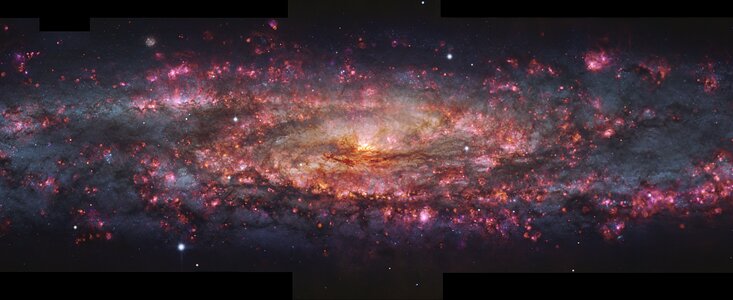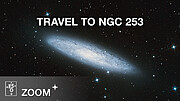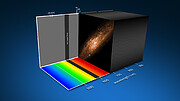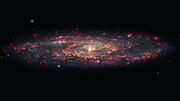Tisková zpráva
Astronomové pořídili nejpodrobnější tisícibarevný snímek galaxie
18. června 2025, Praha
Astronomové vytvořili galaktické mistrovské dílo: velmi detailní snímek, který odhaluje dosud neviděné rysy v galaxii Sochař. Pomocí dalekohledu VLT (Very Large Telescope) Evropské jižní observatoře (ESO) pozorovali tuto blízkou galaxii v tisících barvách současně. Pořízením obrovského množství dat na každém jednotlivém místě vytvořili snímek života hvězd v galaxii Sochař.
„Galaxie jsou neuvěřitelně složité systémy, kterým se stále snažíme porozumět,“ říká výzkumný pracovník ESO Enrico Congiu, který vedl novou studii časopisu Astronomy & Astrophysics o galaxii Sochař. Galaxie dosahující stovek tisíc světelných let napříč jsou extrémně velké, ale jejich vývoj závisí na tom, co se děje na mnohem menších škálách. „Galaxie Sochař se nachází na ideálním místě,“ říká Congiu. „Je dostatečně blízko, abychom mohli rozlišit její vnitřní strukturu a studovat její stavební kameny s neuvěřitelnými detaily, ale zároveň dostatečně velká, abychom ji stále mohli pozorovat jako celý systém.
Stavební prvky galaxie - hvězdy, plyn a prach - vyzařují světlo různých barev. Proto čím více barevných odstínů je na snímku galaxie, tím více se můžeme dozvědět o jejím vnitřním uspořádání. Zatímco běžné snímky obsahují jen několik barev, nová mapa Sochaře jich obsahuje tisíce. To astronomům prozradí vše, co potřebují vědět o hvězdách, plynu a prachu uvnitř galaxie, například o jejich stáří, složení a pohybu.
Aby vědci vytvořili tuto mapu galaxie Sochař, která je od nás vzdálená 11 milionů světelných let a je známá také jako NGC 253, pozorovali ji více než 50 hodin pomocí přístroje MUSE (Multi Unit Spectroscopic Explorer) na dalekohledu VLT ESO. Tým musel spojit dohromady více než 100 expozic, aby pokryl oblast galaxie o šířce asi 65 000 světelných let.
Podle spoluautorky Kathryn Kreckelové z Heidelberské univerzity v Německu to z mapy činí silný nástroj: „Můžeme si přiblížit jednotlivé oblasti, kde se tvoří hvězdy, téměř v měřítku jednotlivých hvězd, ale můžeme také studovat galaxii jako celek.“
Při první analýze dat tým odhalil v galaxii Sochař přibližně 500 planetárních mlhovin, oblastí plynu a prachu vyvržených z umírajících hvězd podobných Slunci. Spoluautor Fabian Scheuermann, doktorand na Heidelberské univerzitě, uvádí toto číslo do kontextu: „Mimo naše galaktické okolí se obvykle setkáváme s méně než 100 detekcemi na galaxii.“
Vzhledem k vlastnostem planetárních mlhovin je lze použít jako ukazatele vzdálenosti k hostitelským galaxiím. „Nalezení planetárních mlhovin nám umožňuje ověřit vzdálenost galaxie, což je zásadní informace, na které závisí další studium galaxie,“ říká Adam Leroy, profesor na Ohio State University v USA a spoluautor studie.
Budoucí projekty využívající tuto mapu budou zkoumat, jak plyn planetárních mlhovin proudí, mění své složení a tvoří hvězdy v celé této galaxii. „Jak mohou mít tak malé procesy tak velký vliv na galaxii, jejíž celá velikost je tisíckrát větší, je stále záhadou,“ říká Congiu.
Další informace
Tento výzkum byl prezentován v článku přijatém k publikaci v časopise Astronomy & Astrophysics.
Skupinu tvoří E. Congiu (European Southern Observatory, Chile [ESO Chile]), F. Scheuermann (Astronomisches Rechen-Institut, Zentrum für Astronomie der Universität Heidelberg, Germany [ARI-ZAH]), K. Kreckel (ARI-ZAH), A. Leroy (Department of Astronomy and Center for Cosmology and Astroparticle Physics, The Ohio State University [OSU], USA), E. Emsellem (European Southern Observatory, Germany [ESO Garching] and Univ. Lyon, Univ. Lyon1, ENS de Lyon, CNRS, Centre de Recherche Astrophysique de Lyon, France), F. Belfiore (INAF – Osservatorio Astrofisico di Arcetri, Italy), J. Hartke (Finnish Centre for Astronomy with ESO [FINCA] and Tuorla Observatory, Department of Physics and Astronomy [Tuorla], University of Turku, Finland), G. Anand (Space Telescope Science Institute, USA), O. V. Egorov (ARI-ZAH), B. Groves (International Centre for Radio Astronomy Research, University of Western Australia, Australia), T. Kravtsov (Tuorla and FINCA), D. Thilker (Department of Physics and Astronomy, The Johns Hopkins University, USA), C. Tovo (Dipartimento di Fisica e Astronomia ‘G. Galilei’, Universit‘a di Padova, Italy), F. Bigiel (Argelander-Institut für Astronomie, Universität Bonn, Germany), G. A. Blanc (Observatories of the Carnegie Institution for Science, USA, and Departamento de Astronomía, Universidad de Chile, Chile), A. D. Bolatto and S. A. Cronin (Department of Astronomy, University of Maryland, USA), D. A. Dale (Department of Physics and Astronomy, University of Wyoming, USA), R. McClain (OSU), J. E. Méndez-Delgado (Instituto de Astronomía, Universidad Nacional Autónoma de México, Mexico), E. K. Oakes (Department of Physics, University of Connecticut, USA), R. S. Klessen (Universität Heidelberg, Zentrum für Astronomie, Institut für Theoretische Astrophysik and Interdisziplinäres Zentrum für Wissenschaftliches Rechnen, Germany, Center for Astrophysics Harvard & Smithsonian, USA, and Elizabeth S. and Richard M. Cashin Fellow at the Radcliffe Institute for Advanced Studies at Harvard University, USA) E. Schinnerer (Max-Planck-Institut für Astronomie, Germany), T. G. Williams (Sub-department of Astrophysics, Department of Physics, University of Oxford, UK).
Evropská jižní observatoř (ESO) umožňuje vědcům z celého světa objevovat tajemství vesmíru ve prospěch všech. Navrhujeme, stavíme a provozujeme pozemní observatoře světové úrovně, které astronomové využívají k řešení vzrušujících záhad vesmíru a šíření fascinace astronomií, a podporujeme mezinárodní spolupráci v oblasti astronomie. ESO bylo založeno jako nadnárodní organizace v roce 1962 a dnes ji podporuje 16 členských států (Belgie, Česká republika, Dánsko, Francie, Finsko, Irsko, Itálie, Německo, Nizozemsko, Polsko, Portugalsko, Rakousko, Spojené království, Španělsko, Švédsko a Švýcarsko), hostitelský stát Chile a Austrálie jako strategický partner. Sídlo ESO a její návštěvnické centrum a planetárium ESO Supernova se nachází nedaleko německého Mnichova, zatímco chilská poušť Atacama, nádherné místo s jedinečnými podmínkami pro pozorování oblohy, je domovem našich dalekohledů. ESO provozuje tři pozorovací stanoviště: La Silla, Paranal a Chajnantor. Na Paranalu provozuje Very Large Telescope a jeho Interferometr, jakož i přehlídkové dalekohledy, jako je VISTA. Na Paranalu bude ESO také hostit a provozovat soustavu Čerenkovových teleskopů (Cherenkov Telescope Array South), největší a nejcitlivější observatoř pro gama záření na světě. ESO společně s mezinárodními partnery provozuje na Chajnantoru observatoř ALMA, která pozoruje oblohu v milimetrovém a submilimetrovém pásmu. Na Cerro Armazones poblíž Paranalu budujeme "největší oko upřené k nebi" - Extremely Large Telescope. Z našich kanceláří v Santiagu v Chile podporujeme naší činnost v zemi a spolupracujeme s chilskými partnery a společností.
Odkazy
- Výzkumný článek
- Fotografie VLT
- Pro novináře: přihlaste se k odběru našich zpráv pod embargem ve vašem jazyce
- Pro vědce: máte příběh? Předložte svůj výzkum
- Nová analýza ESO potvrzuje vážné škody způsobené průmyslovým komplexem plánovaným poblíž Paranalu
Kontakty
Enrico Congiu
European Southern Observatory (ESO)
Santiago, Chile
Email: econgiu@eso.org
Kathryn Kreckel
Heidelberg University
Heidelberg, Germany
Tel.: +49 6221 54-1859
Email: kathryn.kreckel@uni-heidelberg.de
Adam Leroy
The Ohio State University
Columbus, Ohio, USA
Tel.: +1 614 292-1765
Email: leroy.42@osu.edu
Fabian Scheuermann
Heidelberg University
Heidelberg, Germany
Email: f.scheuermann@uni-heidelberg.de
Bárbara Ferreira
ESO Media Manager
Germany, Germany
Tel.: +49 89 3200 6670
Mobil: +49 151 241 664 00
Email: press@eso.org
Anežka Srbljanović (press contact Česko)
ESO Science Outreach Network
a Astronomical Institute of Czech Academy of Sciences
Tel.: +420 323 620 116
Email: eson-czech@eso.org
O zprávě
| Tiskové zpráva č.: | eso2510cs |
| Jméno: | NGC 253, Sculptor Galaxy |
| Typ: | Local Universe : Galaxy : Type : Barred |
| Facility: | Very Large Telescope |
| Instruments: | MUSE |
| Science data: | 2025A&A...700A.125C |
Our use of Cookies
We use cookies that are essential for accessing our websites and using our services. We also use cookies to analyse, measure and improve our websites’ performance, to enable content sharing via social media and to display media content hosted on third-party platforms.
ESO Cookies Policy
The European Organisation for Astronomical Research in the Southern Hemisphere (ESO) is the pre-eminent intergovernmental science and technology organisation in astronomy. It carries out an ambitious programme focused on the design, construction and operation of powerful ground-based observing facilities for astronomy.
This Cookies Policy is intended to provide clarity by outlining the cookies used on the ESO public websites, their functions, the options you have for controlling them, and the ways you can contact us for additional details.
What are cookies?
Cookies are small pieces of data stored on your device by websites you visit. They serve various purposes, such as remembering login credentials and preferences and enhance your browsing experience.
Categories of cookies we use
Essential cookies (always active): These cookies are strictly necessary for the proper functioning of our website. Without these cookies, the website cannot operate correctly, and certain services, such as logging in or accessing secure areas, may not be available; because they are essential for the website’s operation, they cannot be disabled.
Functional Cookies: These cookies enhance your browsing experience by enabling additional features and personalization, such as remembering your preferences and settings. While not strictly necessary for the website to function, they improve usability and convenience; these cookies are only placed if you provide your consent.
Analytics cookies: These cookies collect information about how visitors interact with our website, such as which pages are visited most often and how users navigate the site. This data helps us improve website performance, optimize content, and enhance the user experience; these cookies are only placed if you provide your consent. We use the following analytics cookies.
Matomo Cookies:
This website uses Matomo (formerly Piwik), an open source software which enables the statistical analysis of website visits. Matomo uses cookies (text files) which are saved on your computer and which allow us to analyze how you use our website. The website user information generated by the cookies will only be saved on the servers of our IT Department. We use this information to analyze www.eso.org visits and to prepare reports on website activities. These data will not be disclosed to third parties.
On behalf of ESO, Matomo will use this information for the purpose of evaluating your use of the website, compiling reports on website activity and providing other services relating to website activity and internet usage.
Matomo cookies settings:
Additional Third-party cookies on ESO websites: some of our pages display content from external providers, e.g. YouTube.
Such third-party services are outside of ESO control and may, at any time, change their terms of service, use of cookies, etc.
YouTube: Some videos on the ESO website are embedded from ESO’s official YouTube channel. We have enabled YouTube’s privacy-enhanced mode, meaning that no cookies are set unless the user actively clicks on the video to play it. Additionally, in this mode, YouTube does not store any personally identifiable cookie data for embedded video playbacks. For more details, please refer to YouTube’s embedding videos information page.
Cookies can also be classified based on the following elements.
Regarding the domain, there are:
- First-party cookies, set by the website you are currently visiting. They are stored by the same domain that you are browsing and are used to enhance your experience on that site;
- Third-party cookies, set by a domain other than the one you are currently visiting.
As for their duration, cookies can be:
- Browser-session cookies, which are deleted when the user closes the browser;
- Stored cookies, which stay on the user's device for a predetermined period of time.
How to manage cookies
Cookie settings: You can modify your cookie choices for the ESO webpages at any time by clicking on the link Cookie settings at the bottom of any page.
In your browser: If you wish to delete cookies or instruct your browser to delete or block cookies by default, please visit the help pages of your browser:
Please be aware that if you delete or decline cookies, certain functionalities of our website may be not be available and your browsing experience may be affected.
You can set most browsers to prevent any cookies being placed on your device, but you may then have to manually adjust some preferences every time you visit a site/page. And some services and functionalities may not work properly at all (e.g. profile logging-in, shop check out).
Updates to the ESO Cookies Policy
The ESO Cookies Policy may be subject to future updates, which will be made available on this page.
Additional information
For any queries related to cookies, please contact: pdprATesoDOTorg.
As ESO public webpages are managed by our Department of Communication, your questions will be dealt with the support of the said Department.








